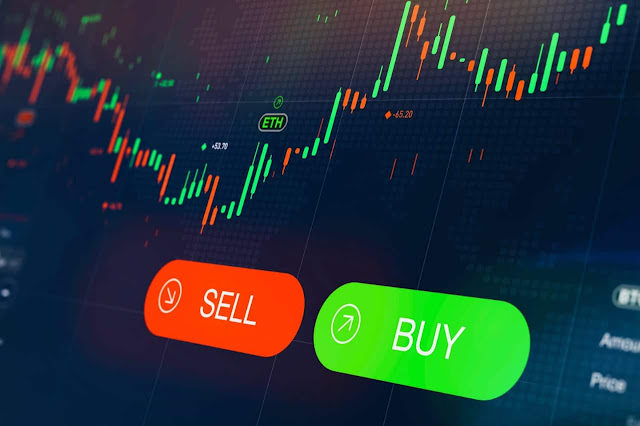With the proliferation of electronic technologies and the web, many investors are choosing to purchase and market stocks to get themselves online rather than paying advisers large commissions to implement transactions. But before you can begin purchasing and selling shares, it is important to comprehend the various kinds of Stock Trading orders and if they're appropriate.
the basic types of inventory Stock Trading orders and the way they match your investment style.
KEY TAKEAWAYS
- depending upon your investment style, several kinds of orders may be used to exchange stocks more efficiently.
- A market purchase only buys (or sells) stocks at the prevailing market costs before the order is satisfied.
- A limit order specifies a particular price at which the arrangement has to be filled, though there's not any guarantee that some or all the order will transaction if the limitation is set too low or high.
- Cease orders, a sort of market purchase, are triggered if a stock moves below or above a specific amount; they're frequently employed as a means to insure against bigger losses or to lock in gains.
Economy Orders Of Basics of Stock Trading
A market purchase is the most elementary kind of commerce. Normally, if you're likely to purchase an inventory , then you are going to pay a price at or near the submitted request . If you're likely to sell a Stock Trading, you'll be given a cost at or near the submitted bidding .
last traded price isn't necessarily the cost where the market order will be implemented. In volatile and overburdened markets, the cost where you really implement (or fulfill ) the transaction can deviate from the last traded price. The cost will stay the exact same just when the bid/ask cost is just at the last traded price.1
Market orders don't guarantee a price tag, however they do promise that the arrangement's instant implementation.
Market orders are very popular among individual investors who wish to purchase or sell a Stock Trading. Even though the investor does not know the specific cost at which the stock is going to be purchased or sold, market orders stocks that trade over tens of thousands of stocks daily will probably be implemented near the bid/ask costs.
A limit purchase , occasionally known as a pending sequence, enables traders to purchase and sell securities at a particular cost in the long run. This sort of arrangement is used to perform a transaction if the purchase price reaches the pre-defined degree; the purchase won't be filled in the event the cost doesn't achieve this amount. In effect, a limitation order sets the minimum or maximum price at which you're prepared to purchase or sell.1
wished to purchase a stock at $10, you can enter a limit order with this sum. This usually means that you wouldn't pay 1 cent over $10 for this specific stock. But, it's still possible you could get it for less than the $10 per share given in this purchase.
There are four Kinds of limit Basics of Stock Trading:
Purchase Limit: an arrangement to Buy a security at or below a specified cost. Limit orders should be placed on the right side of the marketplace to make certain they may accomplish the job of enhancing the cost. To make sure a better cost, the order has to be placed in or above the present marketplace ask.1
Purchase Stop:an arrangement to obtain a security at a price above the current market bid. A stop purchase to purchase becomes active just after a predetermined price level was attained (called the stop level). Purchase stop are orders placed over the marketplace and sell stop orders placed under the market (the contrary of buy and sell limit orders( respectively). After a stop level was attained, the purchase will be instantly converted into a market or limit order.2
Market Stop:an arrangement to sell a security at a price below the current marketplace inquire. Such as the purchase stop, a stop order to sell becomes active just after a given price amount has been attained.2
Market and Limit Basics of Stock Trading Order Prices
When deciding from a limit or market order, investors must know about the additional costs. Normally, the commissions are more economical for market orders compared to limit orders. The gap in commission could be anywhere from a few dollars to over $10. As an instance, a $10 commission on a market order could be boosted around $15 if you put a limitation restriction on it.
Though you save a bit from purchasing the Stock Trading at a lower cost (10 shares x $0.10 = $1), you may lose it at the additional costs for your purchase price ($5), a gap of $4. What's more, in the event of the limit order, it's likely that the inventory does not fall into $49.90 or not. Thus, in case it continues to grow, you might lose the chance to purchase.
Added Basics of Stock Trading Order Types
Now that we have clarified the two Chief orders, Here Is a listing of some Additional restrictions and particular instructions That Lots of Distinct brokerages allow in their own orders:
A stop-loss purchase can also be known as a discontinued market, on-stop purchase, or on-stop market, this is among the very useful orders. This arrangement differs since, unlike the limit and market orders, that can be active when they're entered, this arrangement stays dormant until a specific cost is passed, at that time it's triggered as a market order.
As an example, if a stop-loss sell purchase were put onto the XYZ shares at $45 per share, the purchase could be inactive before the price reached or dropped under $45. The purchase would then be changed to a market order, and the stocks would be offered in the best available cost. You need to think about with this sort of order in case you don't have enough time to see the industry continually but need security from a massive downside move. A fantastic time to utilize a stop order is until you leave on holiday.
These are much like stop-loss orders, however as their name says, there's a limitation on the cost where they will implement. There are two costs given at a stop-limit arrangement: the stop price, which will convert the sequence to a market order, as well as the limit cost . This may mitigate a possible issue with stop-loss orders, which may be triggered during a flash accident when costs plummet but then recover.3
This sort of order is particularly crucial for people who purchase penny stocks. An all-or-none arrangement makes sure that you get the whole amount of inventory you asked or none in any way. That is generally problematic when a stock is extremely illiquid or a limitation is put on the purchase. By way of instance, if you put in an order to purchase 2,000 shares of XYZ but just 1,000 are being marketed, an all-or-none limitation means your order won't be fulfilled until you can find at least 2,000 stocks available at your chosen cost. If you do not put an all-or-none limitation, then your 2,000 share arrangement could be partly filled for 1,000 stocks.4
An IOC order mandates that whatever level of an arrangement which could be implemented from the marketplace (or in a limit) at an incredibly limited time period, often only a couple seconds or not, be full and then the remaining portion of the sequence canceled. If no stocks are exchanged in that"instant" period, then the sequence is canceled entirely.4
This sort of order unites an AON arrangement using an IOC specification; in different words, it mandates that the full purchase dimensions be exchanged and in a really limited period of time, often a couple of seconds or not. If neither condition is fulfilled, the order has been canceled.4
This is a period limitation which it is possible to set on various orders. A good-til-canceled arrangement will stay active until you choose to cancel it. Brokerages will generally restrict the maximum time you may keep an arrangement open (or busy ) to 90 times.
Day Stock Trading
expiry during the GTC education, then the arrangement will typically be put as a day sequence. This implies that following the conclusion of the trading day, the order will perish. When it is not transacted (filled) then you'll need to re-enter it that the subsequent trading day.
A take profit sequence (sometimes known as a profit goal ) is meant to shut out the transaction in a profit once it's attained a specific degree. This sort of arrangement is obviously attached to an open place of a pending sequence.5
Not many brokerages or internet trading platforms permit for each these kinds of orders. Check with your agent if you don't have access to a specific purchase type which you want to utilize.
The Main Point Of Stock Trading
Understanding the distinction between a limitation along with a market order is essential to individual investing. There are occasions where one or another will be appropriate, and the purchase type can be affected by your own investment strategy.
A long-term investor is far more inclined to decide on a market order since it's cheaper as well as the investment choice will be based on principles which will perform over years and years, therefore the present market cost is less of a problem. A dealer, however, is seeking to behave on a shorter-term tendency in the graphs and, thus, is considerably more aware of the industry price paid; where instance, a limit order to purchase using a stop-loss order to market is generally the bare minimum for preparing a trade.
By understanding what every purchase does and how every one may influence your trading, you can determine which dictate is suitable for your investment requirements, saves time, reduces your threat, and, most of all, saves you cash.
Put your trading abilities to the test using our FREE Stock Simulator. Compete with thousands of Investopedia dealers and trade your way to the top! Spread transactions in a digital environment before you start risking your own money. Practice trading strategies in order that when you're prepared to enter the real marketplace, you have had the practice you need.







0 Comments